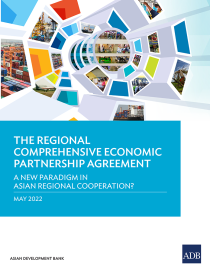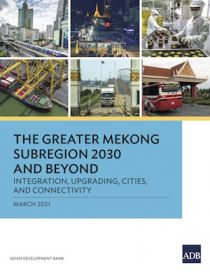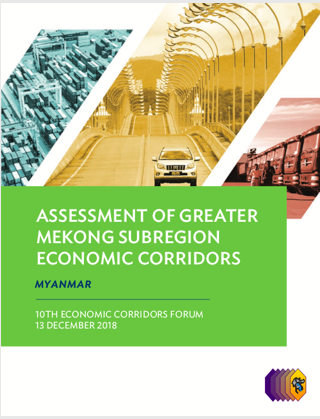
Asian Development Bank and Myanmar: Fact Sheet
ADB remains deeply concerned about recent developments in Myanmar and will continue to consult with shareholders and other stakeholders on any operations in the country.
The Greater Mekong Subregion is working to improve the quality of life and economic vibrancy of its cities and towns by using global best practices in urban development.
The Urban Development Working Group oversees urban development and economic zones as new areas of cooperation in the subregion.
By 2050, the Greater Mekong Subregion is expected to be at least 50% urbanized. This will bring vast changes to the economies of the subregion. What was once a primarily agricultural area is transforming into a place where cities and towns are the main drivers of economic growth. Careful planning is needed to balance urban growth with environmental protection and economic equity so that healthy cities can be enjoyed by all residents.
The Greater Mekong Subregion is working to improve the quality of life and economic vibrancy of its cities through the development of national strategies and projects that incorporate global best practices into the subregion’s urban development. This work has included the first and second Corridor Towns Development Project, which is developing competitive and environmentally friendly cities along vital economic arteries in the subregion. Cross-border economic zones are also being developed.
The COVID-19 pandemic inevitably will leave its mark on cities, physically and socially, echoing for generations to come. This is already evident in terms of urban life. The GMS Program will focus on these effects with measures to respond to current and future crises. The GMS Economic Cooperation Program Strategic Framework 2030 (GMS-2030) will encourage a holistic approach to the future planning of cities so that they are green, smart, competitive, resilient, safe, and inclusive. It will also promote linkages between cities to develop new urban clusters and maximize economies of agglomeration, develop cities in border areas, create linkages with special economic and industrial zones, and improve waste management and pollution in cities located close to GMS rivers and seas. GMS-2030 was endorsed and adopted at the 7th GMS Summit of Leaders in September 2021. It aims to provide a new setting for the development of this subregion for the next decade.
Related
• Urban Development in the Greater Mekong Subregion
• Greater Mekong Subregion Urban Development Strategic Framework
• Second Greater Mekong Subregion Corridor Towns Development Project
• Urban Development Working Group
Focal Persons at the Asian Development Bank
Alan Baird
Water and Urban Development Sector Office Sectors Group
Hinako Maruyama
Water and Urban Development Sector Office Sectors Group
Other Concerned Staff & Consultants
Antonio Ressano
Regional Cooperation and Integration Unit
Southeast Asia Department
Alma Canarejo
Regional Cooperation and Integration Unit
Southeast Asia Department/GMS Secretariat
Send inquiries to GMS Secretariat.

ADB remains deeply concerned about recent developments in Myanmar and will continue to consult with shareholders and other stakeholders on any operations in the country.

This report compares the Regional Comprehensive Economic Partnership (RCEP) with other free trade agreements and suggests how policy makers can promote its successful implementation.
Thailand’s Ministry of Commerce’s Trade Policy and Strategy Office (TPSO) organized the CLMVT+ Forum 2021 on 24-26 August. The forum highlighted the TPSO study emphasizing the importance of achieving an even economic recovery in the GMS.

This publication provides an analysis of key challenges and opportunities for the Greater Mekong Subregion (GMS) to realize its development goals by 2030 and beyond.
This is the joint statement issued at the 23rd GMS Ministerial Conference held in Phnom Penh, Cambodia on 18 November 2019.
The International Finance Corporation is partnering with Thailand-based Amata Corporation to develop sustainability projects for cities, towns, and industrial zones in the Greater Mekong Subregion. The projects will promote green growth and sustainable design practices.
MANILA, PHILIPPINES (12 December 2018) — Senior officials of the Greater Mekong Subregion will convene this week at the 10th GMS Economic Corridors Forum (ECF-10) in Nay Pyi Taw, Myanmar to discuss ways to fast-track infrastructure development and boost growth along key economic corridors connecting the subregion.

This report presents the findings of the assessment of the Myanmar component of the Greater Mekong Subregion economic corridors.
MANILA, PHILIPPINES (10 December 2018) — The Asian Development Bank has approved a $250 million loan to enhance cross-border trade opportunities and improve urban infrastructure and services in Lincang Prefecture in the People’s Republic of China.

GMS East-West Economic Corridor. This aerial view of the border check point on the Lao side of the Mekong River shows the second Thai–Lao Friendship Bridge, which connects Mukdahan province in Thailand with Savannakhet in the Lao People's Democratic Republic. Photo: ADB.
The Greater Mekong Subregion (GMS) Economic Corridors Forum (ECF) in 2018 marks the 20th year of the GMS economic corridor development approach since its formal adoption at the 6th GMS Ministerial Conference in 1998 to accelerate subregional development. It is the 10th year of the forum since its inaugural meeting in Kunming, People’s Republic of China (PRC) in 2008. This is also the first ECF following the 6th GMS Summit in March 2018, which adopted the Hanoi Action Plan 2018–2022 that has among its key elements a spatial strategy focused on the economic corridors.